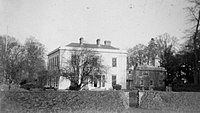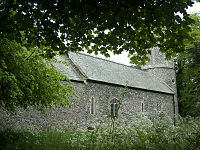Clippesby
{{Infobox town |name=Clippesby |county=Norfolk |os grid ref=TG428146 |latitude=52.675 |longitude=1.590 |post town=Great Yarmouth |postcode=NR29 |dialling code=01493 |population=120 |census year=approx |LG district=Great Yarmouth |constituency=[[Great Yarmouth }} Clippesby is a small village in eastern Norfolk, standing amongst the Norfolk Broads. The B1152 reaches through to connect the village.
The village consists largely of a few rows of small cottages and houses with four buildings of historical relevance, the Church of St. Peter's, the Rectory, the Old Hall (now Old Hall Farm) and Clippesby Hall (formerly Clippesby House). It is surrounded by outlying farmsteads. Farming and tourism comprise the majority of its economy, the latter being based in the grounds of Clippesby Hall.
History
Clippesby is believed to have Danish origins, indicated by the "by" ending to its name. In the Viking Age, the settlement was bordered by the saltwater lagoon that existed before the sandspit where Great Yarmouth now stands formed to block the entrance to the North Sea. Subsequent drainage by windpumps created rich agricultural land upon which the settlement was largely dependent until recent years. There is an entry for Clippesby in the 1086 Domesday Book where it is recorded as Clepesbei.
Clippesby Hall

Clippesby Hall has had two incarnations over its history. The first Hall appears to date from 1585 (although Osbert de Salicibus alias de Willows is recorded as Lord in the reign of Henry II - 1154-1189). It was most notably occupied by Sir Clipesby Crewe, Chief Justice of England and first Recorder of Great Yarmouth. The Old Hall subsequently became a farm and is today known as "Old Hall Farm".
The current Hall was formerly known as Clippesby House.
The second Hall and estate was first owned by the Muskett family and is described in the 1903 sales catalogue.
In 1909 the hall was purchased by the artist Peregrine Feeney and his wife Emily. She was the sister-in-law of the noted pre-raphaelite painter John William Waterhouse who became a regular visitor and painted the hall on at least one occasion.
Originally the Hall had two storeys but following its use by the army in the Second World War the upper floor fell into disrepair and was demolished.
Since the war the estate has been utilised as a market garden, a garden centre and is currently a holiday park. The Hall is still a family home.
Clippesby Church

The Church of St Peter is one of 124 existing round-tower churches in Norfolk.
St Peter's is adjacent to Clippesby Hall once the residence of the artist Peregrine Feeney. The Hall and presumably the Church were visited regularly by the noted Pre-Raphaelite John William Waterhouse. In another artistic link the church was the subject of a painting by John Sell Cotman. Another distinction is a fine Arts and Crafts style stained glass window "Suffer little children", the first professional commission by M E Aldrich Rope, c1919.
Church History
The church is thought to date from Anglo-Saxon times, though there is no mention of it in the Domesday Book. The round tower is certainly of Saxon construction as is a small (now sealed) window, whereas the North doorway with its characteristic zig-zag moulding is Norman. The tower was augmented with an octagonal bell tower in the early 1900s. A tiny mass dial (2" Across) is located in the porch and dates from c.1400. The church register dates from 1737 and resides at the Norfolk Records Office.
Outside links
- Website with photos of Clippesby St Peter, a round-tower church
- Clippesby Hall,
- Website with a photo of JWWaterhouse at Clippesby Hall